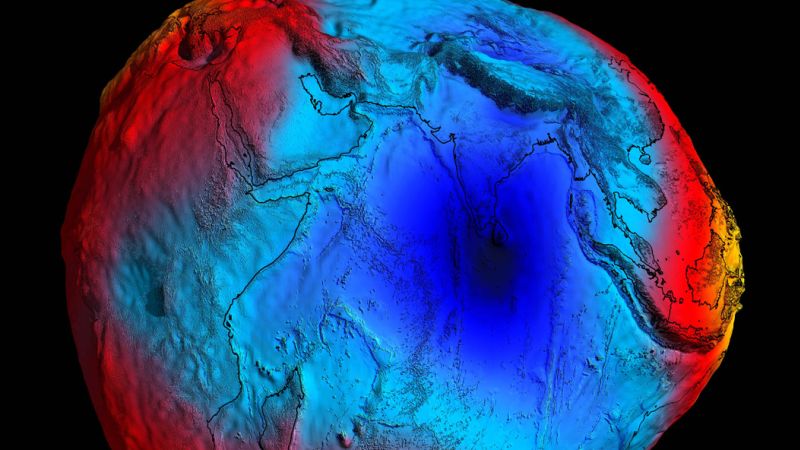Scientists have discovered a “gravity hole” in the Indian Ocean, where Earth’s gravitational pull is weaker and the sea level dips by over 328 feet. This anomaly has puzzled geologists for years, but now researchers from the Indian Institute of Science have found a credible explanation: plumes of magma coming from deep inside the planet. Using supercomputers, the team simulated the area’s formation and found that an ancient ocean played a role. Our planet is not a perfect sphere, but rather an ellipsoid, and its density differences affect its surface and gravity. The Indian Ocean geoid low, as it is officially called, is the largest and most unexplained low in the geoid. To find answers, the researchers ran simulations going back 140 million years and found that the presence of magma plumes was the key factor in the formation of the gravity hole. These findings shed light on the mysterious phenomenon and provide a deeper understanding of Earth’s structure.Unveiling the Mystery of Ancient Ocean Disappearance and Earth’s Plumes
Did you know that an ancient ocean played a crucial role in the formation of Earth’s plumes? It all started when India’s landmass drifted and eventually collided with Asia millions of years ago. As India moved north, the ocean between the Indian plate and Asia disappeared, leading to the formation of these mysterious plumes. But how exactly did this happen?
According to scientists, as the oceanic plate descended into the mantle, it could have triggered the formation of the plumes by bringing low-density material closer to the Earth’s surface. This fascinating discovery sheds light on the geological processes that have shaped our planet over millions of years.
But that’s not all. The research also reveals that the geoid low, a phenomenon associated with the plumes, formed around 20 million years ago. Will it ever disappear or shift away? The answer lies in how these mass anomalies in the Earth move around. It could persist for a very long time or vanish in the future, depending on plate movements.
This groundbreaking study has caught the attention of experts worldwide. Huw Davies, a professor at Cardiff University in the UK, describes it as “certainly interesting” and believes it will inspire further research on this captivating topic.
If you’re intrigued by the mysteries of our planet’s past and want to delve deeper into the fascinating world of Earth’s plumes and ancient oceans, this is a must-read. Join us on this scientific journey as we uncover the secrets hidden beneath the Earth’s surface.
Source: CNNNew Study Reveals Surprising Findings About the Indian Ocean Geoid Low
Dr. Alessandro Forte, a respected geology professor, commends the recent computer simulations conducted to investigate the origin of the Indian Ocean geoid low. This study represents a significant improvement over previous research by incorporating hot rising mantle plumes, in addition to the descent of cold material across the mantle.
However, Forte does point out a couple of flaws in the study’s execution. One major issue is the failure to reproduce a powerful mantle dynamic plume that erupted 65 million years ago under Réunion Island. This eruption, responsible for the Deccan Traps, one of Earth’s largest volcanic features, is absent from the model simulation.
Another concern raised by Forte is the discrepancy between the predicted geoid shape in the computer simulation and the actual one. Notably, the differences are particularly noticeable in the Pacific Ocean, Africa, and Eurasia. While the study mentions a moderate correlation of around 80%, a more precise measure of the numerical match is not provided, suggesting potential deficiencies in the simulation.
Despite these limitations, Ghosh, one of the researchers involved, acknowledges that not every factor can be accounted for in the simulations. The Earth’s past appearance is not known with absolute precision, and as we go further back in time, confidence in the models decreases. Additionally, the complexities of plate movements over time may introduce discrepancies. Nevertheless, the study’s overall conclusion regarding the reason for the Indian Ocean geoid low remains clear.
Intriguingly, this study sheds new light on the origin of the Indian Ocean geoid low, offering valuable insights into the Earth’s geological history. While it may not provide all the answers, it represents a significant step forward in our understanding of this fascinating phenomenon.
Scientists Unveil Surprising Explanation for Mysterious ‘Gravity Hole’ in the Indian Ocean
In a groundbreaking discovery, scientists have finally unraveled the enigma surrounding the mysterious ‘gravity hole’ that has long puzzled researchers in the Indian Ocean. This perplexing phenomenon, characterized by an abnormal gravitational force, has confounded experts for years, but a recent study has shed light on its origins.
The Indian Ocean, known for its vastness and diverse marine life, has been a subject of fascination for scientists across the globe. However, it is the presence of this peculiar gravitational anomaly that has captured the attention of researchers in recent times. The ‘gravity hole’ refers to an area where the gravitational pull is significantly weaker than in the surrounding regions, creating a gravitational anomaly that has perplexed scientists for decades.
The study, conducted by a team of international researchers, utilized advanced satellite technology and data analysis techniques to investigate the underlying cause of this anomaly. The team discovered that the ‘gravity hole’ is a result of a massive underwater crater located deep beneath the ocean’s surface. This crater, estimated to be around 600 kilometers in diameter, is believed to have been formed by a meteorite impact millions of years ago.
The impact of the meteorite created a depression in the ocean floor, altering the gravitational field in the region. The researchers found that the presence of this crater has disrupted the distribution of mass in the Indian Ocean, leading to the abnormal gravitational force observed in the area. The team further explained that the weakened gravitational pull is a consequence of the crater’s mass, which is significantly lower than the surrounding ocean floor.
The discovery of this massive crater not only explains the mysterious ‘gravity hole’ but also provides valuable insights into the geological history of the Indian Ocean. The researchers believe that the impact of the meteorite occurred during a time when the Indian Ocean was still in its early stages of formation. This finding suggests that the region has undergone significant geological changes over millions of years, shaping its current landscape.
Furthermore, the study highlights the importance of advanced satellite technology in unraveling complex natural phenomena. The ability to collect precise data from space has revolutionized our understanding of the Earth’s dynamics and has allowed scientists to explore regions that were previously inaccessible. The researchers hope that this discovery will encourage further exploration and investigation into other unexplained gravitational anomalies around the world.
The revelation of the cause behind the ‘gravity hole’ in the Indian Ocean marks a significant milestone in scientific research. It not only resolves a long-standing mystery but also deepens our understanding of the Earth’s geological processes. The study serves as a testament to the relentless pursuit of knowledge by scientists and the power of collaboration in unraveling the secrets of our planet.
As we continue to explore the vast depths of our oceans and the mysteries they hold, it is through such discoveries that we inch closer to comprehending the complexities of our world. The ‘gravity hole’ in the Indian Ocean, once an enigma, now stands as a testament to the remarkable capabilities of human curiosity and scientific endeavor.









